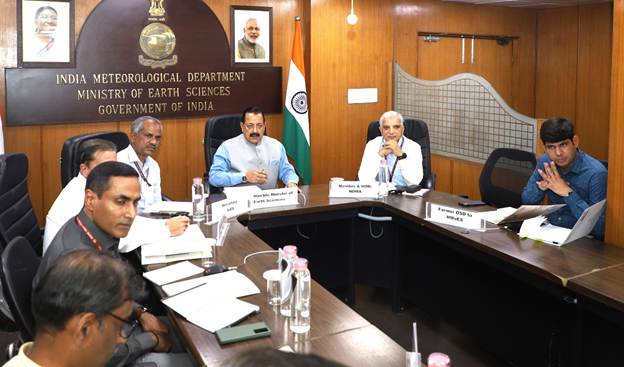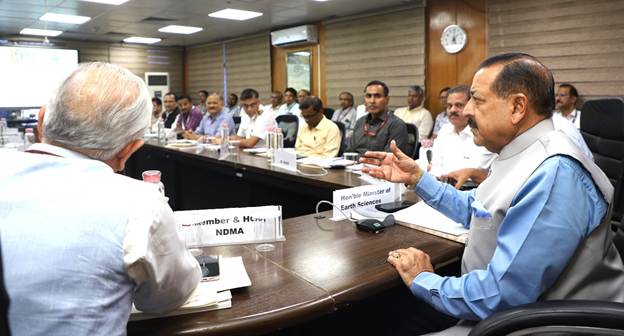Ministry of Earth Sciences
Earth Sciences Minister Dr. Jitendra Singh chairs a high-level meeting of India Meteorological Department (IMD) and key ministries to review India's weather and disaster preparedness
Also rolls out future roadmap for accurate forecasts
For Delhi, which has 18 Automatic Weather Stations (AWS) in operation, the Minister directs officials to expedite the installation of 50 additional systems, with a long-term goal of scaling up to 100 AWS, this move aims to bring Delhi’s weather forecasting infrastructure on par with global standards
Minister briefed about the progress of "Mission Mausam” initiative launched by PM Modi, which aims to revolutionize India’s weather monitoring infrastructure
India to Have 126 Doppler Radars by 2026 as Govt Ramps Up Weather Monitoring
प्रविष्टि तिथि:
25 APR 2025 6:52PM by PIB Delhi
In a decisive move to strengthen India’s meteorological capabilities, Union Minister of State (Independent Charge) for Science and Technology; Earth Sciences and Minister of State for PMO, Department of Atomic Energy, Department of Space, Personnel, Public Grievances and Pensions, Dr. Jitendra Singh on Thursday chaired a high-level meeting of India Meteorological Department (IMD) and key ministries to review India's weather and disaster preparedness, and also rolled out roadmap for accurate forecast.

The Minister called for expediting expansion of Doppler Weather Radar (DWR) coverage and modernization of meteorological systems across the country.
At present, Delhi has 18 Automatic Weather Stations (AWS) in operation. During the review, the Minister directed officials to expedite the installation of 50 additional systems, with a long-term goal of scaling up to 100 AWS. This move aims to bring Delhi’s weather forecasting infrastructure on par with global standards. These automated systems are designed to deliver highly specific, accurate, and timely forecasts, significantly enhancing the city’s capacity to monitor and respond to changing weather conditions.
Amidst the growing frequency of extreme weather events, Dr. Jitendra Singh emphasized the urgent need for real-time, impact-based forecasting that can help minimize damage and save lives. “No weather hazard should go undetected or unpredicted,” the Minister asserted, underscoring the government’s resolve to build a resilient early warning system that reaches every corner of the country.

A key highlight of the review was the ambitious expansion of the Doppler Weather Radar network, which is set to rise from the current 37 operational radars to 73 by 2025-26, and further to 126 by 2026. The new installations are being planned in high-priority regions such as Bengaluru, Raipur, Ahmedabad, Ranchi, Guwahati, and Port Blair, among others.
The Minister was briefed on the selection of radar sites and the overall progress of the “Mission Mausam” launched by PM Narendra Modi, which aims to revolutionize India’s weather monitoring infrastructure. The plan includes improved satellite meteorology systems, upgraded numerical prediction models, and a more robust radar-based forecasting mechanism.
“The ability to track extreme weather events with greater precision will not only boost disaster management efforts but also directly benefit farmers, fishermen, aviation, and various other sectors,” Dr. Jitendra Singh noted during the meeting, which included senior officials such as Earth Sciences Secretary Dr. M. Ravichandran and IMD Director General Dr. Mrutyunjay Mohapatra.
The review also took stock of financial allocations and approvals pending for key weather-related infrastructure projects. Dr. Jitendra Singh urged ministries to fast-track decisions to ensure timely implementation.
With climate change intensifying the unpredictability of weather systems, the push for enhanced radar coverage and more efficient dissemination of forecasts is seen as critical for national preparedness. The meeting, according to ministry officials, marks a significant step in India’s journey toward becoming a global leader in climate resilience and disaster risk reduction.
The Minister’s review has now set the wheels in motion for a more coordinated and technologically advanced response to India’s meteorological challenges.
*****
NKR/PSM
(रिलीज़ आईडी: 2124379)
आगंतुक पटल : 1312